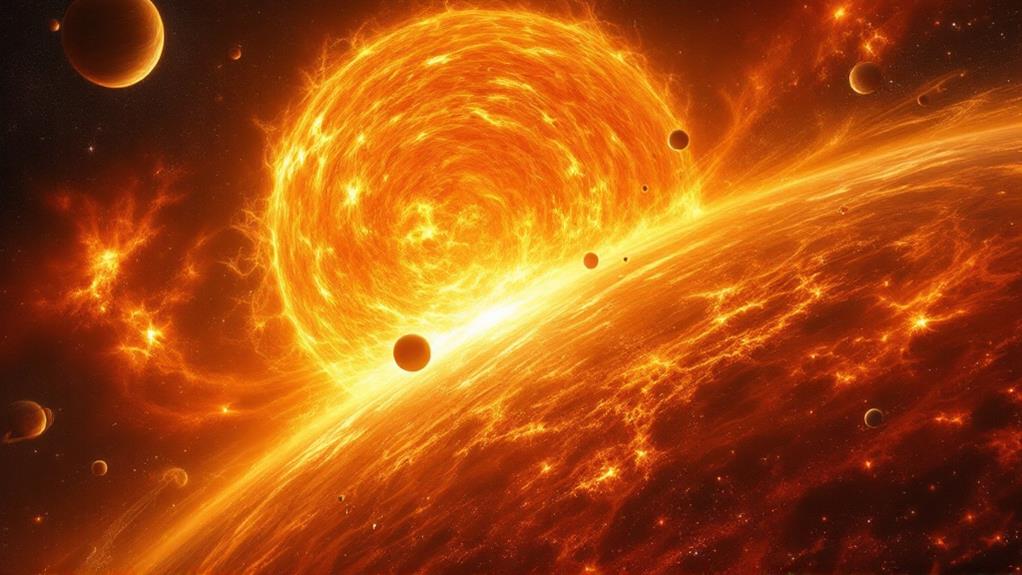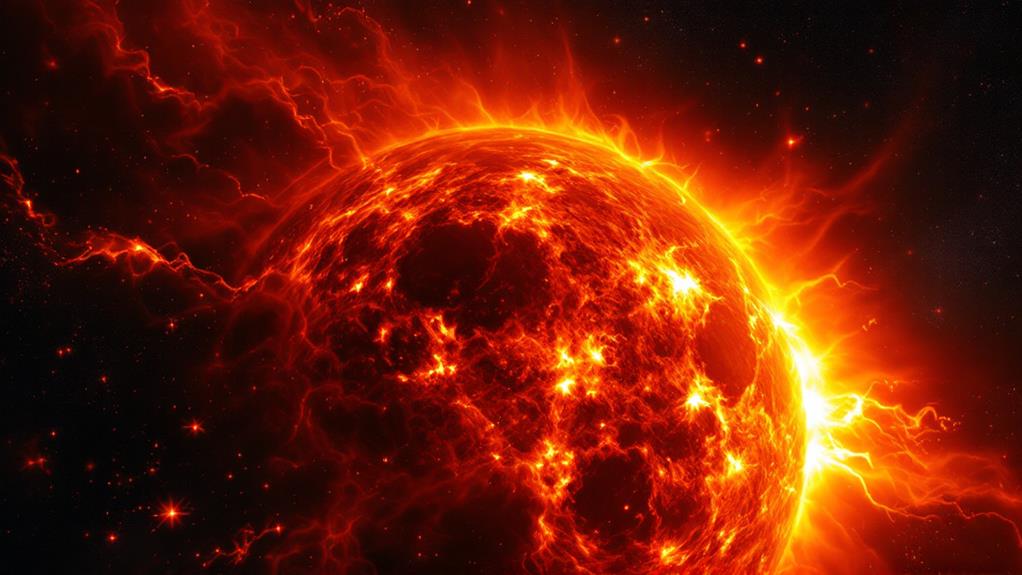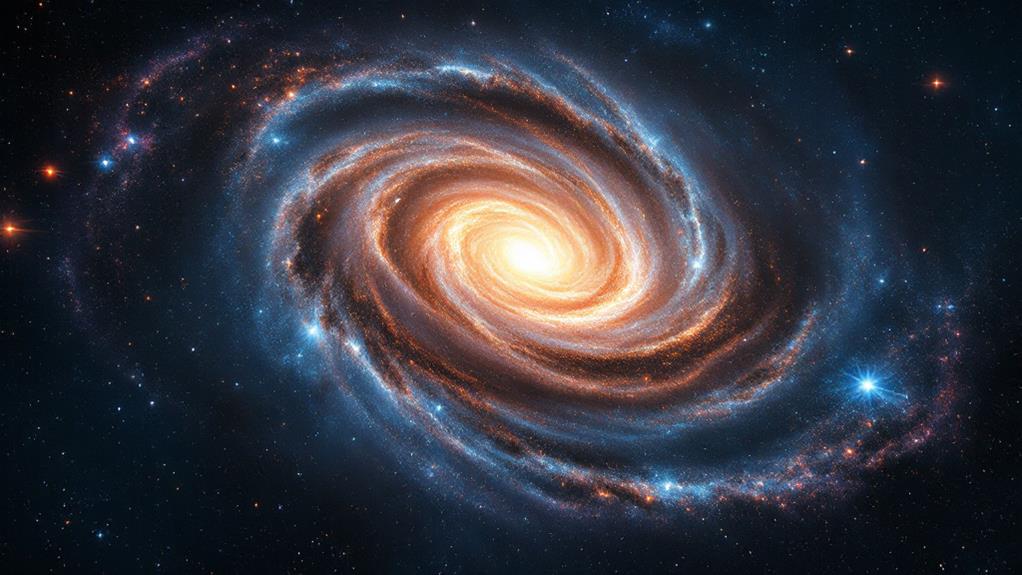Interesting Facts About the Sun: The Star That Powers Our Solar System

Uncover fascinating facts about the Sun, our solar system's dynamic powerhouse. Composed mainly of hydrogen and helium, the Sun's core reaches a scorching 15 million degrees Celsius. Here, nuclear fusion converts hydrogen into helium, releasing energy that warms our planet. Its surface features mysterious sunspots linked to solar flares and an 11-year magnetic cycle. The solar wind, a stream of charged particles, shapes our planet's magnetosphere. The Sun's lifecycle will ultimately lead it from its current stable phase to a red giant and then a white dwarf. There's much more to the Sun than meets the eye.
Composition and Structure
The Sun, a massive celestial body, is primarily composed of hydrogen and helium, making up about 98% of its total mass. As you investigate its structure, you'll find it's divided into several layers, each playing a significant role in its function. At its core, where temperatures soar to around 15 million degrees Celsius, hydrogen atoms are densely packed, creating immense pressure. This core temperature is vital for the Sun's energy production.
Surrounding the core, you have the radiative and convective zones, which transport energy outward. The radiative zone lies just outside the core, where energy moves slowly through radiation. Above this, the convective zone churns with hot plasma currents, transferring energy to the solar surface.
Now, consider the solar atmosphere, which consists of the photosphere, chromosphere, and corona. The photosphere is the visible surface, where sunspots and solar flares appear. Above it, the chromosphere emits a reddish glow, especially visible during solar eclipses. The outermost layer, the corona, extends millions of kilometers into space and is surprisingly hotter than the surface. Understanding these layers helps you grasp how the Sun's composition and structure affect its behavior and influence our solar system.
Nuclear Fusion Process
Understanding the Sun's composition and layered structure sets the stage for exploring its core function: the nuclear fusion process. At the heart of the Sun lies the solar core, where the magic of energy production happens. In this intensely hot and dense environment, fusion reactions occur, converting hydrogen into helium. This process, known as hydrogen burning, is the primary source of the Sun's energy.
The solar core reaches temperatures of about 15 million degrees Celsius, where temperature gradients play an essential role. These gradients drive the fusion reactions by providing the necessary conditions for atomic nuclei to overcome repulsive forces and collide. When hydrogen nuclei fuse, they form helium and release an enormous amount of energy. This energy release powers the Sun and provides the light and warmth that reach Earth.
This process is a part of stellar nucleosynthesis, a sequence of reactions that produce different elements in stars. The energy released from these fusion reactions travels outward through the Sun's layers, eventually reaching the surface and radiating into space. Without the nuclear fusion process in the solar core, the Sun wouldn't be able to sustain life on Earth.
Sunspots and Solar Flares

Sunspots and solar flares captivate scientists and sky-watchers alike with their intriguing behaviors and impacts. You might wonder what these phenomena are and why they matter. Sunspots are dark, cooler areas on the Sun's surface, appearing darker because they're cooler than their surroundings. They're part of the Sun's 11-year sunspot cycles, during which the number of sunspots increases to a peak and then decreases. This cycle affects solar activity, including solar flares.
Solar flares are intense bursts of radiation emanating from the Sun's atmosphere. When you hear about their flare intensity, it refers to the amount of energy released. Flares can disrupt communications and navigation systems on Earth, so understanding them is essential. They often occur near sunspots, where the magnetic energy is stored. When this energy is suddenly released, it can cause a flare.
The Sun's Magnetic Field
While gazing at the Sun's dynamic surface, you might not immediately realize that its magnetic field plays an important role in solar phenomena. The Sun's magnetic field is incredibly complex and constantly changing, directly influencing the solar phenomena you observe. It stretches far beyond the visible surface, affecting the entire solar system. This magnetic field is responsible for creating sunspots, solar flares, and even the magnificent auroras on Earth.
The Sun's magnetic poles switch approximately every 11 years during what's known as the solar cycle. This cycle results in increased solar activity and can lead to spectacular magnetic storms. These storms can impact Earth's technological systems, including satellite operations and power grids. So, while it may seem distant and unrelated to our daily lives, the Sun's magnetic field has significant effects.
Heliospheric dynamics, governed by the Sun's magnetic field, shape the space environment throughout the solar system. The heliosphere is a vast bubble-like region of space dominated by the Sun's magnetic field and solar wind. Understanding this magnetic field is vital to understanding the general behavior of our Sun and its impact on everything from planetary atmospheres to interstellar space.
Solar Wind Effects

The solar wind, a stream of charged particles flowing outward from the Sun, plays an important role in shaping space weather and impacting planetary environments. You might not see it, but this powerful flow constantly interacts with planets, including Earth. One of the most fascinating solar wind interactions is with our planet's magnetic field. It shapes the magnetosphere, providing protection from harmful cosmic rays and solar radiation. These interactions can also trigger breathtaking auroras, the shimmering curtains of light you see near the poles.
Beyond Earth, the solar wind affects other planets and even the vast expanse of space. It influences cosmic ray influx, the high-energy particles from outer space that constantly bombard the solar system. By modulating their intensity, the solar wind helps shield planets from excessive cosmic ray exposure, which can be harmful to both technology and biological life.
The solar wind isn't just a cosmic bystander; it plays a significant role in space exploration. Understanding its effects is vital for future missions, ensuring the safety of spacecraft and astronauts. So, next time you admire the night sky, remember the unseen dance of particles that makes it all possible.
Lifecycle of the Sun
As you consider the solar wind's impact on our solar system, it's intriguing to think about the Sun's own expedition through time. The Sun, like all stars, undergoes a fascinating odyssey known as stellar evolution. This process transforms the Sun through numerous solar phases, each contributing to its life story.
Initially, the Sun began as a dense cloud of gas and dust. Over millions of years, it contracted under its own gravity to form a protostar. This marked the beginning of its expedition through the main sequence, where it currently resides.
During the main sequence phase, the Sun steadily fuses hydrogen into helium in its core. This process provides the energy that powers our solar system. As the hydrogen in the core depletes, the Sun will enter the red giant phase, expanding dramatically and altering its appearance.
Here's a brief overview of the Sun's lifecycle:
- Protostar Formation: The Sun's origin from a gas cloud.
- Main Sequence: The current phase, marked by hydrogen fusion.
- Red Giant: The Sun will expand and cool.
- Planetary Nebula: The outer layers will be expelled.
- White Dwarf: The final phase, a remnant core.
Understanding these solar phases provides insight into the natural progression of stellar evolution.
Impact on Earth's Climate

Consider how the Sun's dynamic behavior directly influences Earth's climate. As the Sun emits solar radiation, it acts as a driving force behind climate variability on our planet. You might not realize it, but changes in the Sun's activity, such as sunspots and solar flares, can alter the amount of solar radiation reaching Earth. This, in turn, affects temperature patterns and weather systems across the globe.
When solar radiation increases, Earth absorbs more energy, leading to warmer temperatures. Conversely, a decrease in solar radiation can trigger cooler periods. This ebb and flow of solar activity have historically been linked to both natural warming and cooling phases, contributing to climate variability.
Moreover, the Sun's energy plays a significant role in processes like photosynthesis and ocean circulation, which are essential for maintaining Earth's climate balance. A subtle shift in solar radiation can influence these processes, affecting ecosystems and weather patterns. By understanding the Sun's impact on climate variability, you can appreciate the intricate connection between our star and the environment. So, while you might not see the Sun's influence directly, its role in shaping Earth's climate is undeniable and profound.
Observing the Sun Safely
Gazing at the Sun requires caution due to its intense brightness and potential to damage your eyes. Directly looking at it, even for a brief moment, can lead to serious eye injuries. Ordinary sunglasses types, no matter how dark, won't protect you from the harmful rays. For safe solar observation, you need specialized equipment.
- Solar Viewing Glasses: Use glasses designed specifically for solar observation. They're made to block harmful rays completely and let you view the Sun safely.
- Pinhole Projector: Create a simple device using cardboard to project the Sun's image onto a surface, allowing you to observe it indirectly.
- Solar Filters for Telescopes: If you have a telescope, verify it has a proper solar filter. Attach it to the front end, never the eyepiece, to prevent damage to both your eyes and the equipment.
- Solar Viewing Binoculars: These come with built-in solar filters, offering a great way to observe the Sun safely without additional attachments.
- Online Resources: Access live streams and images from observatories online. This method guarantees you're completely safe while enjoying stunning solar details.
Always prioritize safety when observing the Sun to protect your vision.



